
Stepstone Falls via Ben Utter Trail
| Destination: | Stepstone Falls | |
| Trails: | Ben Utter Trail, North-South Trail, woods road | |
| Region: | RI - Southern Arcadia Management Area | |
| Location: | Exeter, RI | |
| Rating: | Easy | |
| Features: | River, cascades, old mill sites, slabs | |
| Distance: | 3.4 miles | |
| Elevation Gain: | Minimal | |
| Hiking Time: | Actual: 1:45 | |
| Outing Duration: | Actual: 2:30 | |
| Season: | Summer | |
| Hike Date: | 09/07/2007 (Friday) | |
| Last Updated: | 06/08/2009 | |
| Weather: | 90 degrees in the shade | |
| Author: | Webmaster |
Route Summary

- Start at the Ben Utter Trailhead located on Austin Farm Road.
- Follow the yellow and blue blazes. At the first fork in the trail, taking either route will quickly rejoin to the main route - but I recommend the right-hand fork to stay closer to the river.
- Just after reaching a guardrail, turn right to follow the yellow and blue-blazed footpath (ignore the blue-blazed woods road on the left).
- At the next junction a yellow-blazed trail will go straight and a white and blue-blazed trail will turn right. Turn right here.
- You will eventually reach Stepstone Falls on this trail.
- Continue beyond Stepstone Falls to reach the gravel Falls River Road.
- Turn left to cross the road bridge over Falls River, then turn left again to follow a blue and yellow-blazed trail.
- At the picnic pavilion, follow the yellow blazes that leave the area on the right.
- Climb a short hill to an old paved woods road then turn left and follow this blue-blazed road for a while.
- Near the top of a long hill, turn left to follow a blue-blazed dirt road.
- When you reach the intersection at the guardrail that we had encountered earlier, bear right to continue following the woods road.
- When you reach the gate at the end of the woods road, turn left.
- You are now back on Austin Farm Road. Follow it around to the left and you will reach your vehicle after 0.1 mile.
| Place | Split Time |
Total Time |
|||
|---|---|---|---|---|---|
| Ben Utter Trailhead on Austin Farm Road | 0:00 | 0:00 | |||
| Junction at guardrail | 0:14 | 0:14 | |||
| Junction with white-blazed trail | 0:24 | 0:38 | |||
| Stepstone Falls | 0:15 | 0:53 | |||
| Falls River Road | 0:05 | 0:38 | |||
| Jct. of paved woods road and gravel woods road | 0:22 | 1:20 | |||
| Junction at guardrail | 0:15 | 1:35 | |||
| Austin Farm Road (end of woods road) | 0:08 | 1:43 | |||
| Ben Utter Trailhead on Austin Farm Road | 0:02 | 1:45 |
|
|
|||||
|
|
|||||


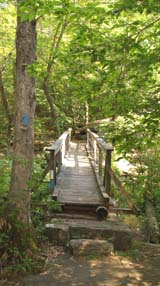
|
|
|||||



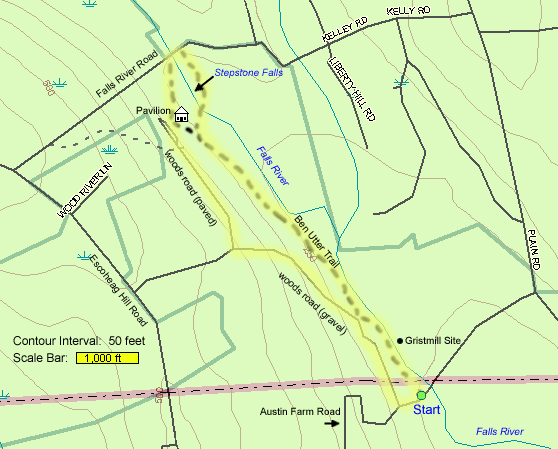
Trail Guide
 This walk along a small river offered many interesting sights: the picturesque river, remains of a gristmill, fabulous slabs, cascades, and pleasant woods, to name a few.
This walk along a small river offered many interesting sights: the picturesque river, remains of a gristmill, fabulous slabs, cascades, and pleasant woods, to name a few.I would like to say the cascades were gorgeous but they were totally dry when I viewed them in September. This would be an enjoyable hike anytime but I think the best season to visit would be in the spring: the river and falls would be at full force and the abundant mountain laurel shrubs would be in bloom. Perhaps that was why I was the only one on the trail, but it was a still a very worthy walk.
I followed Ben Utter Trail and a woods road to make a loop. The Ben Utter Trail is mostly a narrow footpath which follows close to the Falls River for about half of its length. Falls River is actually a section of the Wood River and is a popular stream for trout fishing. Ben Utter Trail coincides with the North-South long-distance trail that traverses Rhode Island from top to bottom. The return part of the loop consisted mostly of a wide woods road. The route is flat, alternating with some gentle ups and downs.
The first part of Ben Utter Trail is blazed in yellow (for the Ben Utter Trail) and blue (for the North-South Trail). Only foot travel is allowed on the path by the river. For mountain bikers or horseback riders following the North-South Trail, they must take the woods road which pretty much parallels the river trail to the left.
The path immediately starts out right next to the river. In spite of its rocky bed, the water was quiet here and peacefully reflected the green of the tree canopy above it. The forest consisted mostly of hardwoods but there were also some impressively sized white pines.
 I encountered some young witch hazel (Hamamelis virginiana L.) trees with strange galls protruding from the upper leaf surfaces. They looked like little red buds or elongated chocolate chips. The galls were covered with minute white hairs and both the galls and leaves seemed to have a sprinkling of white debris on them. A reader kindly informed me that these are called cone galls and are produced by an aphid, Hormaphis hamamelidis. The gall provides both food and shelter for the female aphid.
I encountered some young witch hazel (Hamamelis virginiana L.) trees with strange galls protruding from the upper leaf surfaces. They looked like little red buds or elongated chocolate chips. The galls were covered with minute white hairs and both the galls and leaves seemed to have a sprinkling of white debris on them. A reader kindly informed me that these are called cone galls and are produced by an aphid, Hormaphis hamamelidis. The gall provides both food and shelter for the female aphid.Typical woodland plants were present such as the low-growing partridgeberry, white wood aster, Indian cucumber root in fruit, evergreen Christmas fern, and running cedar clubmoss. There was also some smartweed which has spikes of tiny pink flowers.
I quickly came to a fork in the trail. Bearing left leads up and over a small hill; bearing right leads down to the river bank then back up a small rise where the two trails rejoin and become one again. The ridge that the left-hand fork goes over was once part of an earthen dam built for a gristmill. And if you follow the right-hand fork, you'll be able to see some remains of the mill.
Taking the right-hand fork, after about 20 yards, look across the river and you will see, only partially obstructed by tree trunks, stone walls about 4 feet high forming what looks like the corner of a building. The advantage of the low-flow of the river was that I was able to easily walk across the river's black volcanic-looking rocks and check everything out from a better viewpoint. While crossing, I saw some deer tracks in the mud. Closer to the river bank (on the side opposite the trail) appears to be the remains of a millrace or tailrace. Basically it looks like a man-made gorge with stone walls.
 During the age when waterwheels were commonly used for power, a millrace was the channel that directed water from a stream to the waterwheel. Some millraces were several miles long - the length being required in order to build up the head of water so that the drop would produce enough power to move the waterwheel. After the water flowed into the buckets and moved the wheel, the water was then channeled back into the stream via a tailrace - a more direct course back to the main waterway.
During the age when waterwheels were commonly used for power, a millrace was the channel that directed water from a stream to the waterwheel. Some millraces were several miles long - the length being required in order to build up the head of water so that the drop would produce enough power to move the waterwheel. After the water flowed into the buckets and moved the wheel, the water was then channeled back into the stream via a tailrace - a more direct course back to the main waterway.A gristmill's purpose was to grind grains into flour. Another type of waterwheel-powered mill was sawmills which cut timber into lumber. Later, along the Ben Utter Trail, there is reportedly an old sawmill site to the left of the trail (look for a short spur path). I didn't spot the site but I did see dry channels that probably served as its millraces.
Continuing along the trail, I shortly reached a guardrail. Here a blue-blazed woods road goes left and the Ben Utter/North-South Trails (here, blazed in yellow and blue) go right. We will be returning on the woods road but for now turn right onto the footpath to follow the Ben Utter Trail. It's along this section of trail - between this junction and the next - that you should look for the sawmill site and millraces.
This segment of the route travels away from Falls River. You will quickly encounter many mountain laurels (Kalmia latifolia) bordering the path. Mountain laurels produce pink and white blossoms in June.
While walking through this area, my attention was caught by dozens of black-colored birds flying overhead, from right to left. As I watched, mesmerized, the dozens eventually become hundreds. I spent about 5 or 10 minutes watching a steady stream of flyers progress above the trail. Several birds landed, but not long enough for me to get a good look at them. They seemed to be totally black so maybe they were blackbirds.
 Moving along, the next trail junction was encountered while heading up a hill. The yellow-blazed trail continues straight up the hill and the white and blue-blazed trail makes a sharp right. The yellow-blazed trail leads to a picnic area that we will visit on our return trip but not via this path. Go right here to continue following the Ben Utter and North-South Trails - now blazed in white and blue instead of yellow and blue.
Moving along, the next trail junction was encountered while heading up a hill. The yellow-blazed trail continues straight up the hill and the white and blue-blazed trail makes a sharp right. The yellow-blazed trail leads to a picnic area that we will visit on our return trip but not via this path. Go right here to continue following the Ben Utter and North-South Trails - now blazed in white and blue instead of yellow and blue.This segment was rockier with interesting boulders and it wound its way back to the banks of the river. There was a really murky looking section where the water almost looked like solid mud. I had to toss in a small twig just to make certain it really was liquid.
There were some young American chestnuts (Castanea dentata) growing along the trail. Unfortunately, due to the chestnut blight fungus (Cryphonectria parasitica), this species is destined to never reach maturity, existing only as a shrub or small tree. Prior to 1900, the American chestnut was the most abundant large tree in the eastern forest, making up 25% of all hardwoods and attaining heights of 80 feet tall with trunks four feet in diameter. Due to a blight that was inadvertently imported on Asiatic chestnut seedlings around 1904, the American chestnut population was virtually wiped out within 50 years. Trees surviving today rarely produce nuts.
 Back to the trail. It wasn't long before I reached a wooden footbridge crossing Falls River. Looking downstream was a narrow rocky streambed that later widened into something a bit more substantial. And upstream was a slab-filled watercourse... at this point we're very close to Stepstone Falls.
Back to the trail. It wasn't long before I reached a wooden footbridge crossing Falls River. Looking downstream was a narrow rocky streambed that later widened into something a bit more substantial. And upstream was a slab-filled watercourse... at this point we're very close to Stepstone Falls.On the opposite side of the bridge is a wonderful ledgy area. I crossed the bridge, went left for just a few feet, then ignored the main trail to the left and instead went straight ahead to the back of the ledges. Here I followed a footpath leading past the ledges, through some thickets, and eventually to the shore of the river closer to the wider section downstream that I had spied from the bridge. The path dumped me into a small clearing but only provided a small opening to the actual shoreline. Due to the shrubs on the banks there wasn't much of a view and there were no convenient riverside boulders.
So I returned to the slabs next to the bridge and explored that area and had lunch. There were some chickadees flitting about. After replenishing my energy, I resumed walking on the main trail and quickly reached Stepstone Falls... well, except the falls weren't in action on the day I visited. But I could see the dry slabs that the water would normally step over. I've seen a photo of the falls during heavy water flow and it is really impressive.
But I have to say, the dry falls were almost as impressive and certainly more accessible. I could walk all the way across where the river normally flowed. There was a slab "bridge" that would normally be covered with water. The cascades consist of a couple of wide terraces each dropping about two feet. There was a "hairy" boulder that seemed to be covered with some kind of dried out moss or other type of growth. And on both sides of the river at this point were many beautiful slabs well worth exploring.
 Continuing along the trail, I quickly reached the gravel Falls River Road. Turn left to cross the road bridge over Falls River, then turn left again to follow a blue and yellow-blazed trail. Here, there is a split rock with a tree growing out of it. This footpath will soon lead to an abandoned picnic area with a rotting pavilion. There is a fireplace on either end of the pavilion and there's even a new-looking picnic table under the roof. But I noticed some of the supports and other sections were badly rotting and I didn't dare step foot inside. The hearths also seemed to be in a state of decay.
Continuing along the trail, I quickly reached the gravel Falls River Road. Turn left to cross the road bridge over Falls River, then turn left again to follow a blue and yellow-blazed trail. Here, there is a split rock with a tree growing out of it. This footpath will soon lead to an abandoned picnic area with a rotting pavilion. There is a fireplace on either end of the pavilion and there's even a new-looking picnic table under the roof. But I noticed some of the supports and other sections were badly rotting and I didn't dare step foot inside. The hearths also seemed to be in a state of decay.Follow the yellow blazes that leave this area on the right - this is opposite the opening in the pavilion. The yellow blazes that leave the area straight ahead would lead back to the junction of the yellow and white trails that we encountered earlier. The trail to the right quickly leads up a short hill to an old paved woods road.
Just before reaching the road, you will pass a small stone structure on the right. This little stone hut has some kind of rusting piece of machinery in it with a wheel attached to it. The engraving on the equipment reads, "The Deming Co. Salem Ohio".
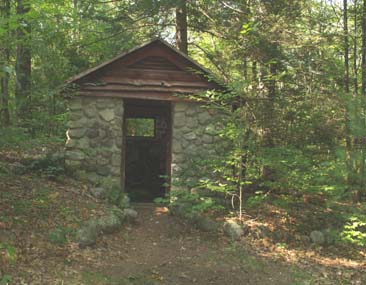
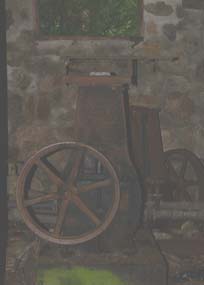
When you reach the paved road, turn left and follow this route for a while. This is pleasant walk through hardwoods with wood ferns bordering the roadsides. This route is blazed in blue. You will end up traversing a long, gentle uphill. Near the top of this hill, look for a dirt road that leads off to the left. The blue blazes are hard to spot at this turn because the tree that they happen to be on is rotted out right were the double-blazes (indicating a turn) happen to be.
If like me, you are enjoying the walk so much that you breeze right past the turn, you will eventually reach a gate and the paved Escoheag Hill Road, from which would be a 2-mile road walk back to your starting point (1 mile of which would be on a fairly busy, no-shoulder, paved road). When I realized where I was, I turned around to go find the turn I missed. It was a pleasant detour.

So when you see the dirt road near the top of the hill, turn left and head down this stony route with poor footing. There will be blue blazes on the sidelines. The use of this trail by horses is evidenced by horse manure so watch your step.
Next you will reach the intersection at the guardrail that we had encountered earlier. Veer right here to continue following the woods road. From here on out, the route is nice and flat and sandy with no rocks underfoot. When you reach the gate at the end of the woods road, turn left. You are now back on Austin Farm Road. Follow it around to the left and you will reach your vehicle after 0.1 mile.
|
|
|||||
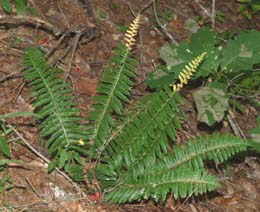
|
|||||

 The trailhead is located in Exeter, Rhode Island. There are two ways to reach the route. This first way via Escoheag Hill Road is the route I followed but I later learned that one of the roads along the way is gated during winter (open only during hunting or fishing seasons). So I will include another set of directions for a route via Frosty Hollow Road that I believe is accessible year round but which I have not personally verified.
The trailhead is located in Exeter, Rhode Island. There are two ways to reach the route. This first way via Escoheag Hill Road is the route I followed but I later learned that one of the roads along the way is gated during winter (open only during hunting or fishing seasons). So I will include another set of directions for a route via Frosty Hollow Road that I believe is accessible year round but which I have not personally verified.Trailhead via Escoheag Hill Road:
- From the junction of Rt. 3 and Rt. 165 in Exeter, drive west on Rt. 165 for about 5.5 miles.
- Turn right onto the paved Escoheag Hill Road.
- After 1 mile, turn right onto the unmarked gravel Austin Farm Road. There are actually two rights here and either one will do - the first one simply leads through a parking area next to an abandoned park building before hooking up with the second right that is the actual road. Both the rights look more like driveways than roads - if you see Old Voluntown Road on your left, then you have gone just a tad too far.
- Once on Austin Farm Road, pass through a gate and travel 1.1 miles from Escoheag Hill Road, bearing left through a junction.
- There will be a small parking area on the left just before a bridge crossing Falls River.
Trailhead via Frosty Hollow Road:
- From the junction of Rt. 3 and Rt. 165 in Exeter, drive west on Rt. 165 for about 3 miles.
- Turn right onto the gravel Frosty Hollow Road when you see the white West Exeter Baptist Church.
- Drive to the end of the road.
- At the T-junction, turn left and follow that road (Austin Farm Road or Plain Road) for 2.2 miles until you cross the river.
- Parking will be on the right just after crossing the river.
Arcadia Management Area Regulations
- There are no entrance fees for the use of the Management Area or Recreation Areas. i.e. Hiking is free.
- All campers must obtain a permit and may camp only in designated areas (although no fee is charged).
- Organized groups of ten or more persons must obtain a special-use permit.
- Shelter rental: $15/night
- Pavilion rental: $15/day
- Horseman's Area: $3/night
About Arcadia Management Area
Located in southwestern Rhode Island, Arcadia Management Area spans Richmond, Exeter, Hopkinton, and West Greenwich and consists of over 14,000 mostly forested acres.
 This outdoor recreation area is actively managed for hiking, mountain biking, horseback riding, hunting, fishing, swimming, and boating. "Multiple use" management principles apply, assuring a safe and satisfying experience for hunters and non-hunters alike.
This outdoor recreation area is actively managed for hiking, mountain biking, horseback riding, hunting, fishing, swimming, and boating. "Multiple use" management principles apply, assuring a safe and satisfying experience for hunters and non-hunters alike.Long stretches of gravel roads in addition to 30 miles of well marked and maintained trails provide many options for hikes both short and long. These same trails are often used by mountain bikers or horseback riders so all users need to act responsibly, show courtesy, and "share the road". Most of the terrain consists of flat walking or relatively gentle inclines.
Major bodies of water within the area include Breakheart Pond, Beach Pond, and Browning Mill Pond. The Wood River, one of the finest trout streams in the state and Rhode Island's best example of a scenic and wild river, flows through the management area. Primary tributaries to the Wood River include the Falls River, Flat River, Parris Brook and Roaring Brook, all found within Arcadia.
Animals likely to be found in the management area include cottontail rabbits, snowshoe hare, gray squirrel, white-tailed deer, fox, raccoon, and mink. Game birds include ruffed grouse, wild turkey, ring-necked pheasant and bobwhite (the latter two are stocked during hunting season).
Arcadia Management Area Forest Environment Headquarters: 401.539.2356
Website by
![]() LeapfrogProgramming.com
LeapfrogProgramming.com
© 1998-2025
![]()
| The information on this site may freely be used for personal purposes but may not be replicated on other websites or publications. If you want to reference some content on this site, please link to us. |



